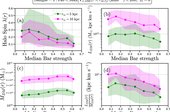 IIA MOUSUMI DAS
IIA MOUSUMI DASThe stellar bar–dark matter halo connection in the TNG50 simulations
Stellar bars in disk galaxies grow as stars in near-circular orbits lose angular momentum to their environments, including their dark matter (DM) halo, and transform into elongated bar orbits. This angular momentum exchange during galaxy evolution hints at a connection between bar properties and the DM halo spin λ, the dimensionless form of DM angular momentum. We investigate the connection between halo spin λ and galaxy properties in the presence/absence of stellar bars, using the cosmological magnetohydrodynamic TNG50 simulations at multiple redshifts (0 < zr < 1). We determine the bar strength (or bar amplitude, A2/A0), using Fourier decomposition of the face-on stellar density distribution. We determine the halo spin for barred and unbarred galaxies (0 < A2/A0 < 0.7) in the center of the DM halo, close to the galaxy's stellar disk. At zr = 0, there is an anticorrelation between halo spin and bar strength. Strongly barred galaxies (A2/A0 > 0.4) reside in DM halos with low spin and low specific angular momentum at their centers. In contrast, unbarred/weakly barred galaxies (A2/A0 < 0.2) exist in halos with higher central spin and higher specific angular momentum. The anticorrelation is due to the barred galaxies' higher DM mass and lower angular momentum than the unbarred galaxies at zr = 0, as a result of galaxy evolution. At high redshifts (zr = 1), all galaxies have higher halo spin compared to those at lower redshifts (zr = 0), with a weak anticorrelation for galaxies having A2/A0 > 0.2. The formation of DM bars in strongly barred systems highlights how angular momentum transfer to the halo can influence its central spin.
 IIA ANUPAMA, G. C
IIA ANUPAMA, G. CSearching for gravitational wave optical counterparts with the zwicky transient facility: summary of O4a
During the first half of the fourth observing run (O4a) of the International Gravitational Wave Network, the Zwicky Transient Facility (ZTF) conducted a systematic search for kilonova (KN) counterparts to binary neutron star (BNS) and neutron star–black hole (NSBH) merger candidates. Here, we present a comprehensive study of the five high-significance (False Alarm Rate less than 1 yr−1) BNS and NSBH candidates in O4a. Our follow-up campaigns relied on both target-of-opportunity observations and re-weighting of the nominal survey schedule to maximize coverage. We describe the toolkit we have been developing, Fritz, an instance of SkyPortal, instrumental in coordinating and managing our telescope scheduling, candidate vetting, and follow-up observations through a user-friendly interface. ZTF covered a total of 2841 deg2 within the skymaps of the high-significance GW events, reaching a median depth of g ≈ 20.2 mag. We circulated 15 candidates, but found no viable KN counterpart to any of the GW events. Based on the ZTF non-detections of the high-significance events in O4a, we used a Bayesian approach, nimbus, to quantify the posterior probability of KN model parameters that are consistent with our non-detections. Our analysis favors KNe with initial absolute magnitude fainter than −16 mag. The joint posterior probability of a GW170817-like KN associated with all our O4a follow-ups was 64%. Additionally, we use a survey simulation software, simsurvey, to determine that our combined filtered efficiency to detect a GW170817-like KN is 36%, when considering the 5 confirmed astrophysical events in O3 (1 BNS and 4 NSBH events), along with our O4a follow-ups. Following Kasliwal et al., we derived joint constraints on the underlying KN luminosity function based on our O3 and O4a follow-ups, determining that no more than 76% of KNe fading at 1 mag day−1 can peak at a magnitude brighter than −17.5 mag.
 IIA SUMANTO CHANDA
IIA SUMANTO CHANDAMore on jacobi metric: Randers–Finsler metrics, frame dragging and geometrisation techniques
In this article, I demonstrate a new method to derive Jacobi metrics from Randers–Finsler metrics by introducing a more generalised approach to Hamiltonian mechanics for such spacetimes and discuss the related applications and properties. I introduce Hamiltonian mechanics with the constraint for relativistic momentum, including a modification for null curves and two applications as exercises: derivation of a relativistic harmonic oscillator and analysis of Schwarzschild Randers–Finsler metric. Then I describe the main application for constraint mechanics in this article: a new derivation of Jacobi metric for time-like and null curves, comparing the latter with optical metrics. After that, I discuss frame dragging with the Jacobi metric and two applications for Randers–Finsler metrics: an alternative to Eisenhart lift, and different metrics that share the same Jacobi metric.
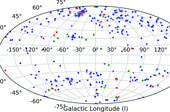 IIA JAYANT MURTHY
IIA JAYANT MURTHYA sky survey of ultraviolet sources observed through AstroSat’s UVIT: A point source catalogue
The Ultra Violet Imaging Telescope (UVIT) onboard India’s first dedicated multiwavelength satellite AstroSat observed a significant fraction of the sky in the ultraviolet with a spatial resolution of 1.4. We present a catalogue of the point sources observed by UVIT in the far ultraviolet (FUV; 1 300–1 800 Å) and near ultraviolet (NUV; 2 000–3 000 Å). We carried out astrometry and photometry of 428 field pointings in the FUV and 54 field pointings in the NUV band, observed in 5 filter bands in each channel, respectively, covering an area of about 63 square degrees. The final catalogue contains about 102 773 sources. The limiting magnitude(AB) of the F148W band filter, that has the largest number of detections is ∼21.3. For the NUV channel, we find the limiting magnitude at around ∼23. We describe the final catalogue and present the results of the statistical analysis.
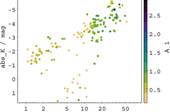 IIA ANWESH KUMAR MISHRA
IIA ANWESH KUMAR MISHRAA summary of instruments proposed for observing pulsating variables from the Mt. Abu observatory
Pulsating variables play a significant role in shaping modern astronomy. Presently it is an exciting era in observational study of variable stars owing to surveys like OGLE and TESS. The vast number of sources being discovered by these surveys is also creating opportunities for 1–2-m class telescopes to provide follow-up observations to characterize these. We present some initial observations of type-II cepheids from the Mt. Abu observatory and highlight the need for dedicated observing runs of pulsating variables. We also present optical designs for several suggested instruments for the Mt. Abu observatory that will contribute towards this goal. We present designs that are fairly simple and yet take due benefit of the unique telescopes and facilities present at the observatory.
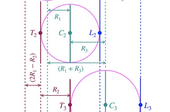 IIA WAGEESH MISHRA
IIA WAGEESH MISHRANon-conventional approach for deriving the radial sizes of coronal mass ejections at different instances: discrepancies in the estimates between remote and in situ observations
Understanding the evolution of radial sizes and instantaneous expansion speeds of coronal mass ejections (CMEs) is crucial for assessing their impact duration on Earth’s environment. We introduce a non-conventional approach to derive the CME’s radial sizes and expansion speeds at different instances during its passage over a single-point in situ spacecraft. We also estimate the CME’s radial sizes and expansion speeds during its journey from the Sun to 1 au using the 3D kinematics of different CME features, including the leading edge, centre, and trailing edge. The continuous 3D kinematics of the CME is estimated by employing the graduated cylindrical shell and stereoscopic self-similar expansion reconstruction methods on multipoint observations from coronagraphs and heliospheric imagers combined with the drag-based model. We choose the 2010 April 3 CME as a suitable case for our study, promising a more accurate comparison of its remote and in situ observations. We show that the introduced non-conventional approach can provide better accuracy in estimating radial sizes and instantaneous expansion speeds of CMEs at different instances. We examine the aspect ratio of the CME, which influences its expansion behaviour and shows the discrepancy between its value in the corona and interplanetary medium. Our study highlights significant inconsistencies in the arrival time, radial size, and expansion speed estimates obtained from remote and in situ observations. We advocate for future studies leveraging multispacecraft in situ observations and our non-conventional approach to analyse them to improve the comprehension of CME dynamics in the solar wind.
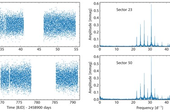 IIA ARUNA GOSWAMI
IIA ARUNA GOSWAMIAsteroseismology of the mild Am δ Sct star HD 118660: TESS photometry and modelling
We present the results of an asteroseismic study of HD 118660 (TIC 171729860), being a chemically peculiar (mild Am) star exhibiting δ Scuti (δ Sct) pulsations. It is based on the analysis of two sectors of time-series photometry from the space mission TESS (Transiting Exoplanet Survey Satellite) and seismic modelling. It yielded the detection of 15 and 16 frequencies for TESS sectors 23 and 50, respectively. The identified pulsation modes include four radial ( = 0) and five dipolar ( = 1) ones. The radial modes are overtones with order n ranging from 3 and 6. Such high values of n are theoretically not expected for stars with the effective temperature of HD 118660 (Teff ≈ 7550 K) located near the red edge of the δ Sct instability strip. To estimate the asteroseismic parameters, we have generated a grid of stellar models assuming a solar metallicity (Z = 0.014) and different values for the convective overshooting parameter (0.1 ≤ αov ≤ 0.3). We conclude that the analysis of the radial modes is insufficient to constrain αov and Z for δ Sct stars. The value for the equatorial velocity of HD 118660 derived from the seismic radius and the rotational frequency is consistent with values found in the literature
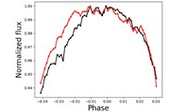 IIA SIVARANI, T
IIA SIVARANI, TLow-resolution transit spectroscopy of three hot Jupiters using the 2 m Himalayan Chandra telescope
Here, we present the low-resolution transmission spectroscopy of three giant planets using the Himalayan Faint Object Spectrograph Camera (HFOSC) on the 2 m Himalayan Chandra Telescope (HCT) in Hanle, India. It is the first application of transmission spectroscopy with HCT. This study presents results from a single transit, each for three planets: HAT-P-1b, KELT-18b, and WASP-127b. The selection of suitable reference stars assisted in accurately tracking slit losses for the long cadence observations that are needed to achieve the required signal-to-noise ratio (SNR). We employ the common mode correction technique, utilizing a white light transit curve to minimize time-dependent systematic errors. The observed spectra for WASP-127b and HAT-P-1b agree with previouslow-resolution transitspectroscopic observations using other observing facilities. We confirm the presence of Rayleigh scattering in the atmosphere of WASP-127b. In addition, we provide the first low-resolution transmission spectrum for KELT-18b. Modelling the exoplanet atmosphere with HFOSC and available IR observations from HST and Spitzer for WASP-127b and HAT-P-1b shows that HFOSC can be an alternative optical instrument to use in conjunction with IR observations to constrain the atmospheric parameters better
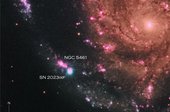 IIA RISHABH SINGH TEJA
IIA RISHABH SINGH TEJAUnravelling the asphericities in the explosion and multifaceted circumstellar matter of SN 2023ixf
We present a detailed investigation of photometric, spectroscopic, and polarimetric observations of the Type II SN 2023ixf. Earlier studies have provided compelling evidence for a delayed shock breakout from a confined dense circumstellar matter (CSM) enveloping the progenitor star. The temporal evolution of polarization in the SN 2023ixf phase revealed three distinct peaks in polarization evolution at 1.4 days, 6.4 days, and 79.2 days, indicating an asymmetric dense CSM, an aspherical shock front and clumpiness in the low-density extended CSM, and an aspherical inner ejecta/He-core. SN 2023ixf displayed two dominant axes, one along the CSM-outer ejecta and the other along the inner ejecta/He-core, showcasing the independent origin of asymmetry in the early and late evolution. The argument for an aspherical shock front is further strengthened by the presence of a high-velocity broad absorption feature in the blue wing of the Balmer features in addition to the P-Cygni absorption post-16 days. Hydrodynamical light-curve modeling indicated a progenitor mass of 10 M⊙ with a radius of 470 R⊙ and explosion energy of 2 × 1051 erg, along with 0.06 M⊙ of 56 Ni, though these properties are not unique due to modeling degeneracies. The modeling also indicated a two-zone CSM: a confined dense CSM extending up to 5 × 1014 cm with a mass-loss rate of 10−2M⊙ yr−1 and an extended CSM spanning from 5 × 1014 to at least 1016 cm with a mass-loss rate of 10−4M⊙ yr−1, both assuming a wind-velocity of 10 km s−1. The early-nebular phase observations display an axisymmetric line profile of [O i], redward attenuation of the emission of Hα post 125 days, and flattening in the Ks-band, marking the onset of dust formation.
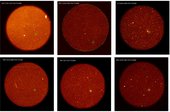 IIA STALIN, C. S
IIA STALIN, C. SUltraviolet flux and spectral variability study of blazars observed with UVIT/AstroSat
Blazars, the peculiar class of active galactic nuclei, are known to show flux variations across the accessible electromagnetic spectrum. Though they have been studied extensively for their flux variability characteristics across wavelengths, information on their ultraviolet (UV) flux variations on timescales of hours is very limited. Here, we present the first UV flux variability study on intraday timescales of a sample of ten blazars comprising two flat-spectrum radio quasars (FSRQs) and eight BL Lacertae objects (BL Lacs). These objects, spanning a redshift (z) range of 0.034 ≤ z ≤ 1.003, were observed in the far-UV (1300−1800 Å) and near-UV (2000−3000 Å) wavebands using the ultraviolet imaging telescope on board AstroSat. UV flux variations on timescales of hours were detected in nine sources out of the observed ten blazars. The spectral variability analysis showed a bluer-when-brighter trend with no difference in the UV spectral variability behavior between the studied sample of FSRQs and BL Lacs. The observed UV flux and spectral variability in our sample of both FSRQs and BL Lacs revealed that the observed UV emission in them is dominated by jet synchrotron process.